Table of Contents
14.1 Introduction
In Class IX, you have studied the classification of given data into ungrouped as well as grouped frequency distributions. You have also learnt to represent the data pictorially in the form of various graphs such as bar graphs, histograms (including those of varying widths) and frequency polygons. In fact, you went a step further by studying certain numerical representatives of the ungrouped data, also called measures of central tendency, namely, mean, median and mode. In this chapter, we shall extend the study of these three measures, i.e., mean, median and mode from ungrouped data to that of grouped data. We shall also discuss the concept of cumulative frequency, the cumulative frequency distribution and how to draw cumulative frequency curves, called ogives.
14.2 Mean of Grouped Data
The mean (or average) of observations, as we know, is the sum of the values of all the observations divided by the total number of observations. From Class IX, recall that if x1, x2,. . ., xn are observations with respective frequencies f1, f2, . . ., fn, then this means observation x1 occurs f1 times, x2 occurs f2 times, and so on.
Now, the sum of the values of all the observations = f1x1 + f2x2 + . . . + fnxn, and the number of observations = f1 + f2 + . . . + fn.
So, the mean of the data is given by
= 
Recall that we can write this in short form by using the Greek letter Σ (capital sigma) which means summation. That is,
*While drawing a cumulative frequency curve or an ogive we assume that there is a class intervals before or after the given class interval with zero frequency. = 
which, more briefly, is written as =  , if it is understood that i varies from 1 to n.
, if it is understood that i varies from 1 to n.
Let us apply this formula to find the mean in the following example.
Example 1 :
The marks obtained by 30 students of Class X of a certain school in a Mathematics paper consisting of 100 marks are presented in table below. Find the mean of the marks obtained by the students.

Solution:
Recall that to find the mean marks, we require the product of each xi with the corresponding frequency fi. So, let us put them in a column as shown in Table 14.1.

Now,  =
=  = 59.3
= 59.3
Therefore, the mean marks obtained is 59.3.
In most of our real life situations, data is usually so large that to make a meaningful study it needs to be condensed as grouped data. So, we need to convert given ungrouped data into grouped data and devise some method to find its mean.
Let us convert the ungrouped data of Example 1 into grouped data by forming class-intervals of width, say 15. Remember that, while allocating frequencies to each
class-interval, students falling in any upper class-limit would be considered in the next class, e.g., 4 students who have obtained 40 marks would be considered in the class-interval 40-55 and not in 25-40. With this convention in our mind, let us form a grouped frequency distribution table (see Table 14.2).

Now, for each class-interval, we require a point which would serve as the representative of the whole class. It is assumed that the frequency of each class-interval is centred around its mid-point. So the mid-point (or class mark) of each class can be chosen to represent the observations falling in the class. Recall that we find the mid-point of a class (or its class mark) by finding the average of its upper and lower limits. That is,
Class mark = 
With reference to Table 14.2, for the class 10-25, the class mark is  , i.e., 17.5. Similarly, we can find the class marks of the remaining class intervals. We put them in Table 14.3. These class marks serve as our xi’s. Now, in general, for the ith class interval, we have the frequency fi corresponding to the class mark xi. We can now proceed to compute the mean in the same manner as in Example 1.
, i.e., 17.5. Similarly, we can find the class marks of the remaining class intervals. We put them in Table 14.3. These class marks serve as our xi’s. Now, in general, for the ith class interval, we have the frequency fi corresponding to the class mark xi. We can now proceed to compute the mean in the same manner as in Example 1.

The sum of the values in the last column gives us Σ fixi. So, the mean  of the given data is given by
of the given data is given by
 =
= 
This new method of finding the mean is known as the Direct Method.
We observe that Tables 14.1 and 14.3 are using the same data and employing the same formula for the calculation of the mean but the results obtained are different. Can you think why this is so, and which one is more accurate? The difference in the two values is because of the mid-point assumption in Table 14.3, 59.3 being the exact mean, while 62 an approximate mean.
Sometimes when the numerical values of xi and fi are large, finding the product of xi and fi becomes tedious and time consuming. So, for such situations, let us think of a method of reducing these calculations.
We can do nothing with the fi’s, but we can change each xi to a smaller number so that our calculations become easy. How do we do this? What about subtracting a fixed number from each of these xi’s? Let us try this method.
The first step is to choose one among the xi’s as the assumed mean, and denote it by ‘a’. Also, to further reduce our calculation work, we may take ‘a’ to be that xi which lies in the centre of x1, x2, . . ., xn. So, we can choose a = 47.5 or a = 62.5. Let us choose a = 47.5.
The next step is to find the difference di between a and each of the xi’s, that is, the deviation of ‘a’ from each of the xi’s.
i.e., di = xi – a = xi – 47.5
The third step is to find the product of di with the corresponding fi, and take the sum of all the fi di’s. The calculations are shown in Table 14.4.

So, from Table 14.4, the mean of the deviations,  =
=  .
.
Now, let us find the relation between  and
and  .
.
Since in obtaining di, we subtracted ‘a’ from each xi, so, in order to get the mean  , we need to add ‘a’ to
, we need to add ‘a’ to  . This can be explained mathematically as:
. This can be explained mathematically as:
Mean of deviations,  =
= 
So,  =
= 
= 
= 
= 
So,  = a +
= a + 
i.e.,  =
= 
Substituting the values of a, Σfidi and Σfi from Table 14.4, we get
 =
=  .
.
Therefore, the mean of the marks obtained by the students is 62.
The method discussed above is called the Assumed Mean Method.
Activity 1 :
From the Table 14.3 find the mean by taking each of xi (i.e., 17.5, 32.5, and so on) as ‘a’. What do you observe? You will find that the mean determined in each case is the same, i.e., 62. (Why ?)
So, we can say that the value of the mean obtained does not depend on the choice of ‘a’.
Observe that in Table 14.4, the values in Column 4 are all multiples of 15. So, if we divide the values in the entire Column 4 by 15, we would get smaller numbers to multiply with fi. (Here, 15 is the class size of each class interval.)
So, let ui =  , where a is the assumed mean and h is the class size.
, where a is the assumed mean and h is the class size.
Now, we calculate ui in this way and continue as before (i.e., find fi ui and then Σfiui). Taking h = 15, let us form Table 14.5.

Let  =
= 
Here, again let us find the relation between  and
and  .
.
We have, ui = 
Therefore,  =
= 
= 
= 
So,  =
= 
i.e.,  = a +
= a + 
So,  =
= 
Now, substituting the values of a, h, Σfiui and Σfi from Table 14.5, we get
 =
= 
= 47.5 + 14.5 = 62
So, the mean marks obtained by a student is 62.
The method discussed above is called the Step-deviation method.
We note that :
the step-deviation method will be convenient to apply if all the di’s have a common factor.
The mean obtained by all the three methods is the same.
The assumed mean method and step-deviation method are just simplified forms of the direct method.
The formula  = a +
= a +  still holds if a and h are not as given above, but are any non-zero numbers such that ui =
still holds if a and h are not as given above, but are any non-zero numbers such that ui =  .
.
Let us apply these methods in another example.
Example 2 :
The table below gives the percentage distribution of female teachers in the primary schools of rural areas of various states and union territories (U.T.) of India. Find the mean percentage of female teachers by all the three methods discussed in this section.

Source : Seventh All India School Education Sur
Solution :
Let us find the class marks, xi, of each class, and put them in a column
(see Table 14.6):

Here we take a = 50, h = 10, then di = xi – 50 and  .
.
We now find diand ui and put them in Table 14.7.

From the table above, we obtain Σfi = 35, Σfixi = 1390,
Σfidi = – 360, Σfiui = –36.
Using the direct method, 
Using the assumed mean method,
 =
=  =
= 
Using the step-deviation method,
 =
= 
Therefore, the mean percentage of female teachers in the primary schools of rural areas is 39.71.
Remark :
The result obtained by all the three methods is the same. So the choice of method to be used depends on the numerical values of xi and fi. If xi and fi are sufficiently small, then the direct method is an appropriate choice. If xi and fi are numerically large numbers, then we can go for the assumed mean method or
step-deviation method. If the class sizes are unequal, and xi are large numerically, we can still apply the step-deviation method by taking h to be a suitable divisor of all the di’s.
Example 3 :
The distribution below shows the number of wickets taken by bowlers in one-day cricket matches. Find the mean number of wickets by choosing a suitable method. What does the mean signify?

Solution :
Here, the class size varies, and the xi,s are large. Let us still apply the step-deviation method with a = 200 and h = 20. Then, we obtain the data as in Table 14.8.

So,  Therefore,
Therefore,  = 200 +
= 200 +  = 200 – 47.11 = 152.89.
= 200 – 47.11 = 152.89.
This tells us that, on an average, the number of wickets taken by these 45 bowlers in one-day cricket is 152.89.
Now, let us see how well you can apply the concepts discussed in this section!
Activity 2 :
Divide the students of your class into three groups and ask each group to do one of the following activities.
1. Collect the marks obtained by all the students of your class in Mathematics in the latest examination conducted by your school. Form a grouped frequency distribution of the data obtained.
2. Collect the daily maximum temperatures recorded for a period of 30 days in your city. Present this data as a grouped frequency table.
3. Measure the heights of all the students of your class (in cm) and form a grouped frequency distribution table of this data.
After all the groups have collected the data and formed grouped frequency distribution tables, the groups should find the mean in each case by the method which they find appropriate.
Exercise 14.1
1. A survey was conducted by a group of students as a part of their environment awareness programme, in which they collected the following data regarding the number of plants in 20 houses in a locality. Find the mean number of plants per house.

Which method did you use for finding the mean, and why?
2. Consider the following distribution of daily wages of 50 workers of a factory.

Find the mean daily wages of the workers of the factory by using an appropriate method.
3. The following distribution shows the daily pocket allowance of children of a locality. The mean pocket allowance is Rs 18. Find the missing frequency f.

4. Thirty women were examined in a hospital by a doctor and the number of heartbeats per minute were recorded and summarised as follows. Find the mean heartbeats per minute for these women, choosing a suitable method.

5. In a retail market, fruit vendors were selling mangoes kept in packing boxes. These boxes contained varying number of mangoes. The following was the distribution of mangoes according to the number of boxes.

Find the mean number of mangoes kept in a packing box. Which method of finding the mean did you choose?
6. The table below shows the daily expenditure on food of 25 households in a locality.

Find the mean daily expenditure on food by a suitable method.
7. To find out the concentration of SO2 in the air (in parts per million, i.e., ppm), the data was collected for 30 localities in a certain city and is presented below:
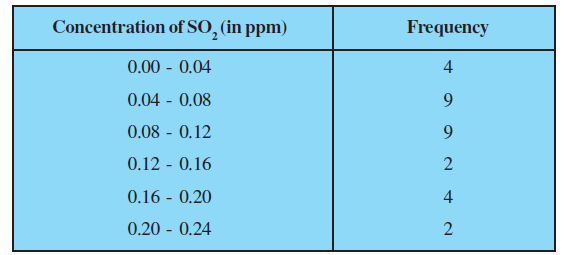
Find the mean concentration of SO2 in the air.
8. A class teacher has the following absentee record of 40 students of a class for the whole term. Find the mean number of days a student was absent.

9. The following table gives the literacy rate (in percentage) of 35 cities. Find the mean literacy rate.

14.3 Mode of Grouped Data
Recall from Class IX, a mode is that value among the observations which occurs most often, that is, the value of the observation having the maximum frequency. Further, we discussed finding the mode of ungrouped data. Here, we shall discuss ways of obtaining a mode of grouped data. It is possible that more than one value may have the same maximum frequency. In such situations, the data is said to be multimodal. Though grouped data can also be multimodal, we shall restrict ourselves to problems having a single mode only.
Let us first recall how we found the mode for ungrouped data through the following example.
Example 4 :
The wickets taken by a bowler in 10 cricket matches are as follows:
2 6 4 5 0 2 1 3 2 3
Find the mode of the data.
Solution :
Let us form the frequency distribution table of the given data as follows:

Clearly, 2 is the number of wickets taken by the bowler in the maximum number (i.e., 3) of matches. So, the mode of this data is 2.
In a grouped frequency distribution, it is not possible to determine the mode by looking at the frequencies. Here, we can only locate a class with the maximum frequency, called the modal class. The mode is a value inside the modal class, and is given by the formula:
Mode = 
where l = lower limit of the modal class,
h = size of the class interval (assuming all class sizes to be equal),
f1 = frequency of the modal class,
f0 = frequency of the class preceding the modal class,
f2 = frequency of the class succeeding the modal class.
Let us consider the following examples to illustrate the use of this formula.
Example 5 :
A survey conducted on 20 households in a locality by a group of students resulted in the following frequency table for the number of family members in a household:

Find the mode of this data.
Solution :
Here the maximum class frequency is 8, and the class corresponding to this frequency is 3 – 5. So, the modal class is 3 – 5.
Now
modal class = 3 – 5, lower limit (l) of modal class = 3, class size (h) = 2
frequency (f1) of the modal class = 8,
frequency (f0) of class preceding the modal class = 7,
frequency (f2) of class succeeding the modal class = 2.
Now, let us substitute these values in the formula :
Mode = 
= 
Therefore, the mode of the data above is 3.286.
Example 6 :
The marks distribution of 30 students in a mathematics examination are given in Table 14.3 of Example 1. Find the mode of this data. Also compare and interpret the mode and the mean.
Solution :
Refer to Table 14.3 of Example 1. Since the maximum number of students (i.e., 7) have got marks in the interval 40 - 55, the modal class is 40 - 55. Therefore,
the lower limit (l) of the modal class = 40,
the class size (h) = 15,
the frequency (f1) of modal class = 7,
the frequency (f0) of the class preceding the modal class = 3,
the frequency (f2) of the class succeeding the modal class = 6.
Now, using the formula:
Mode =  ,
,
we get Mode =  = 52
= 52
So, the mode marks is 52.
Now, from Example 1, you know that the mean marks is 62.
So, the maximum number of students obtained 52 marks, while on an average a student obtained 62 marks.
Remarks :
1. In Example 6, the mode is less than the mean. But for some other problems it may be equal or more than the mean also.
2. It depends upon the demand of the situation whether we are interested in finding the average marks obtained by the students or the average of the marks obtained by most of the students. In the first situation, the mean is required and in the second situation, the mode is required.
Activity 3 :
Continuing with the same groups as formed in Activity 2 and the situations assigned to the groups. Ask each group to find the mode of the data. They should also compare this with the mean, and interpret the meaning of both.
Remark :
The mode can also be calculated for grouped data with unequal class sizes. However, we shall not be discussing it.
Exercise 14.2
1. The following table shows the ages of the patients admitted in a hospital during a year:

Find the mode and the mean of the data given above. Compare and interpret the two measures of central tendency.
2. The following data gives the information on the observed lifetimes (in hours) of 225 electrical components :

Determine the modal lifetimes of the components.
3. The following data gives the distribution of total monthly household expenditure of 200 families of a village. Find the modal monthly expenditure of the families. Also, find the mean monthly expenditure :

4. The following distribution gives the state-wise teacher-student ratio in higher secondary schools of India. Find the mode and mean of this data. Interpret the two measures.
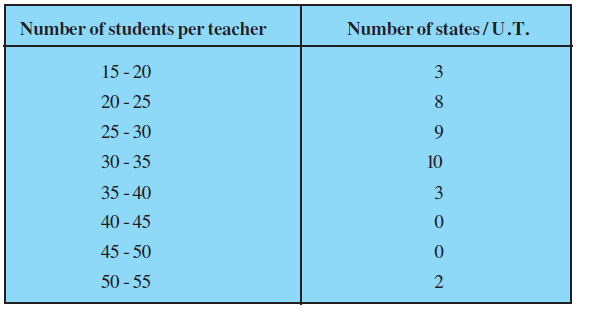
5. The given distribution shows the number of runs scored by some top batsmen of the world in one-day international cricket matches.
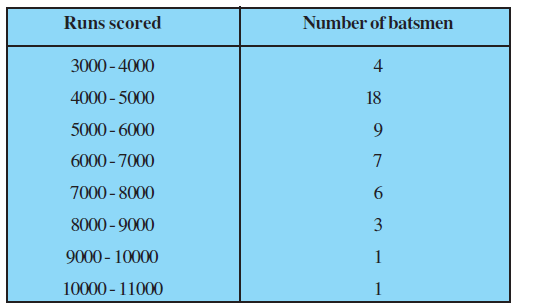
Find the mode of the data.
6. A student noted the number of cars passing through a spot on a road for 100 periods each of 3 minutes and summarised it in the table given below. Find the mode of the data :

14.4 Median of Grouped Data
As you have studied in Class IX, the median is a measure of central tendency which gives the value of the middle-most observation in the data. Recall that for finding the median of ungrouped data, we first arrange the data values of the observations in ascending order. Then, if n is odd, the median is the  th observation. And, if n is even, then the median will be the average of the
th observation. And, if n is even, then the median will be the average of the  and the
and the  observations.
observations.
Suppose, we have to find the median of the following data, which gives the marks, out of 50, obtained by 100 students in a test :

First, we arrange the marks in ascending order and prepare a frequency table as follows :
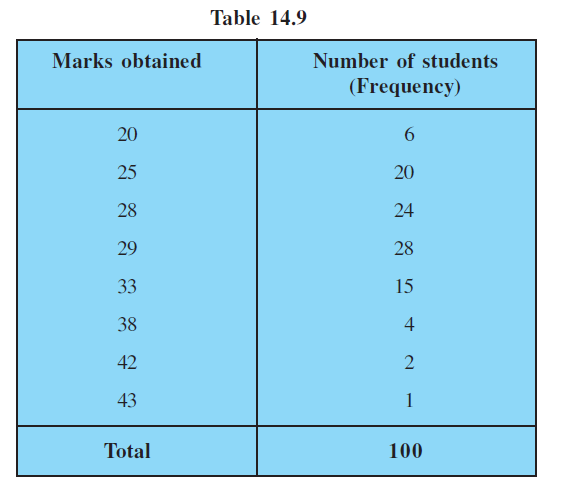
Here n = 100, which is even. The median will be the average of the  th and the
th and the  th observations, i.e., the 50th and 51st observations. To find these observations, we proceed as follows:
th observations, i.e., the 50th and 51st observations. To find these observations, we proceed as follows:
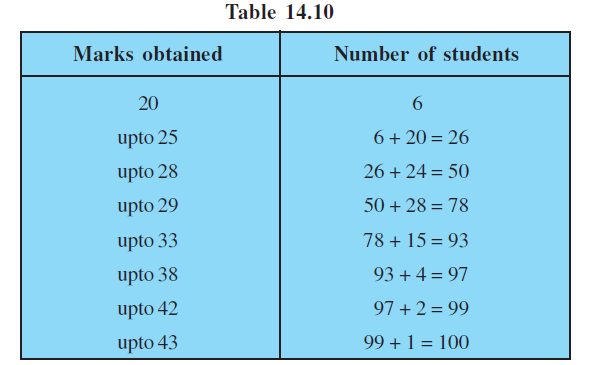
Now we add another column depicting this information to the frequency table above and name it as cumulative frequency column.
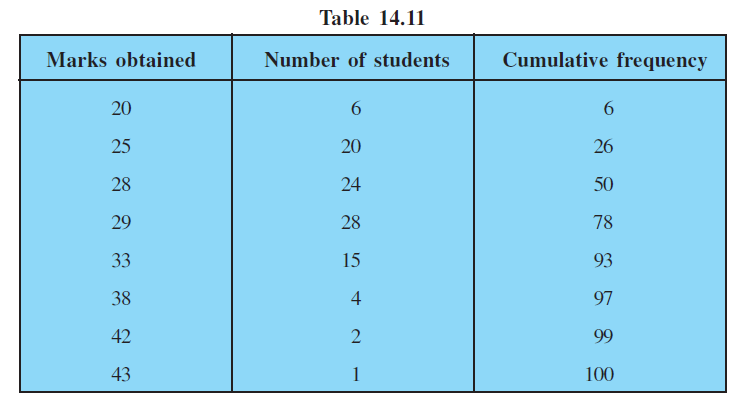
From the table above, we see that:
50th observaton is 28 (Why?)
51st observation is 29
So, Median = 
Remark :
The part of Table 14.11 consisting Column 1 and Column 3 is known as Cumulative Frequency Table. The median marks 28.5 conveys the information that about 50% students obtained marks less than 28.5 and another 50% students obtained marks more than 28.5.
Now, let us see how to obtain the median of grouped data, through the following situation.
Consider a grouped frequency distribution of marks obtained, out of 100, by 53 students, in a certain examination, as follows:
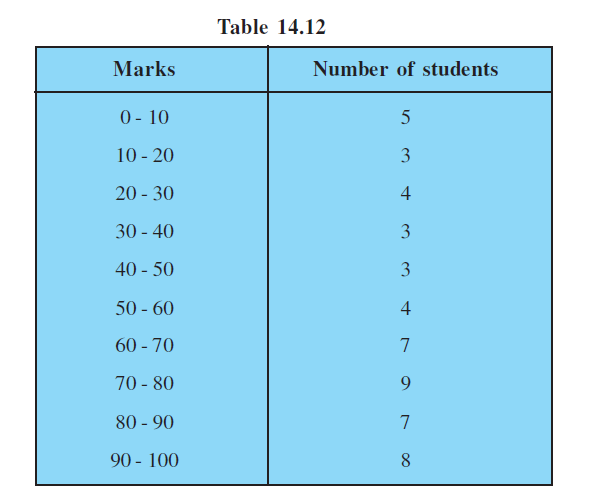
From the table above, try to answer the following questions:
How many students have scored marks less than 10? The answer is clearly 5.
How many students have scored less than 20 marks? Observe that the number of students who have scored less than 20 include the number of students who have scored marks from 0 - 10 as well as the number of students who have scored marks from 10 - 20. So, the total number of students with marks less than 20 is 5 + 3, i.e., 8. We say that the cumulative frequency of the class 10-20 is 8.
Similarly, we can compute the cumulative frequencies of the other classes, i.e., the number of students with marks less than 30, less than 40, . . ., less than 100. We give them in Table 14.13 given below:
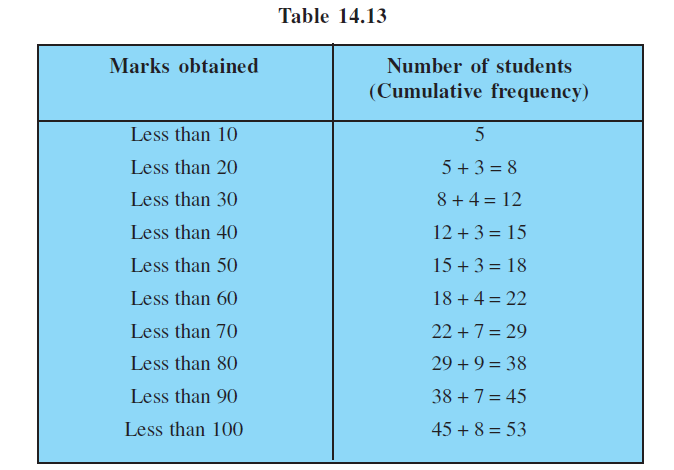
The distribution given above is called the cumulative frequency distribution of the less than type. Here 10, 20, 30, . . . 100, are the upper limits of the respective class intervals.
We can similarly make the table for the number of students with scores, more than or equal to 0, more than or equal to 10, more than or equal to 20, and so on. From Table 14.12, we observe that all 53 students have scored marks more than or equal to 0. Since there are 5 students scoring marks in the interval 0 - 10, this means that there are 53 – 5 = 48 students getting more than or equal to 10 marks. Continuing in the same manner, we get the number of students scoring 20 or above as 48 – 3 = 45, 30 or above as 45 – 4 = 41, and so on, as shown in Table 14.14.
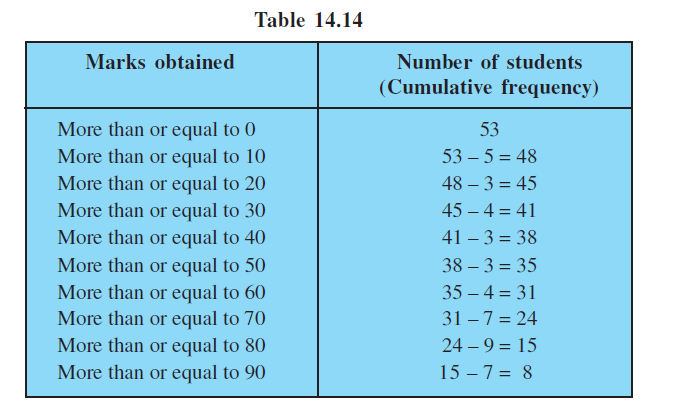
The table above is called a cumulative frequency distribution of the more than type. Here 0, 10, 20, . . ., 90 give the lower limits of the respective class intervals.
Now, to find the median of grouped data, we can make use of any of these cumulative frequency distributions.
Let us combine Tables 14.12 and 14.13 to get Table 14.15 given below:
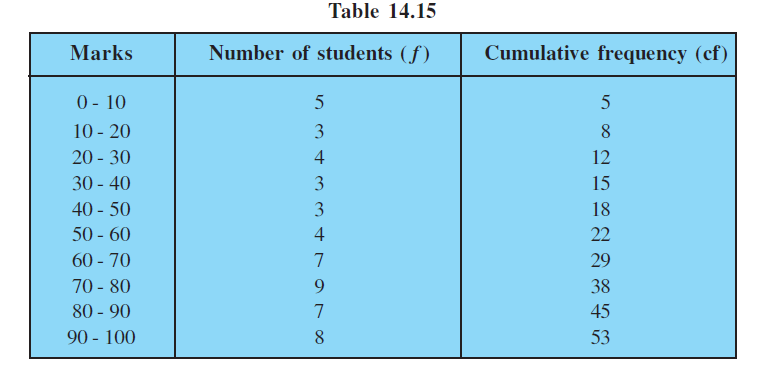
Now in a grouped data, we may not be able to find the middle observation by looking at the cumulative frequencies as the middle observation will be some value in a class interval. It is, therefore, necessary to find the value inside a class that divides the whole distribution into two halves. But which class should this be?
To find this class, we find the cumulative frequencies of all the classes and  . We now locate the class whose cumulative frequency is greater than (and nearest to)
. We now locate the class whose cumulative frequency is greater than (and nearest to)  This is called the median class. In the distribution above, n = 53. So,
This is called the median class. In the distribution above, n = 53. So,  = 26.5. Now 60 – 70 is the class whose cumulative frequency 29 is greater than (and nearest to)
= 26.5. Now 60 – 70 is the class whose cumulative frequency 29 is greater than (and nearest to)  , i.e., 26.5.
, i.e., 26.5.
Therefore, 60 – 70 is the median class.
After finding the median class, we use the following formula for calculating the median.
Median = 
where l = lower limit of median class,
n = number of observations,
cf = cumulative frequency of class preceding the median class,
f = frequency of median class,
h = class size (assuming class size to be equal).
Substituting the values  l = 60, cf = 22, f = 7, h = 10
l = 60, cf = 22, f = 7, h = 10
in the formula above, we get
Median = 
= 60 + 
= 66.4
So, about half the students have scored marks less than 66.4, and the other half have scored marks more than 66.4.
Example 7 :
A survey regarding the heights (in cm) of 51 girls of Class X of a school was conducted and the following data was obtained:
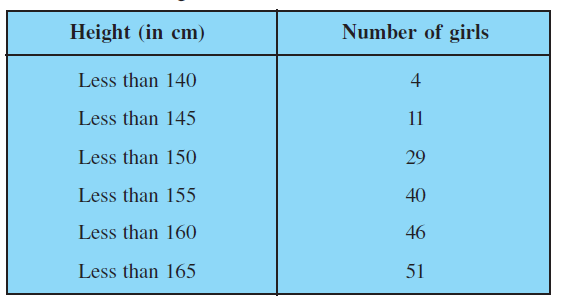
Find the median height.
Solution :
To calculate the median height, we need to find the class intervals and their corresponding frequencies.
The given distribution being of the less than type, 140, 145, 150, . . ., 165 give the upper limits of the corresponding class intervals. So, the classes should be below 140, 140 - 145, 145 - 150, . . ., 160 - 165. Observe that from the given distribution, we find that there are 4 girls with height less than 140, i.e., the frequency of class interval below 140 is 4. Now, there are 11 girls with heights less than 145 and 4 girls with height less than 140. Therefore, the number of girls with height in the interval 140 - 145 is 11 – 4 = 7. Similarly, the frequency of 145 - 150 is 29 – 11 = 18, for 150 - 155, it is 40 – 29 = 11, and so on. So, our frequency distribution table with the given cumulative frequencies becomes:
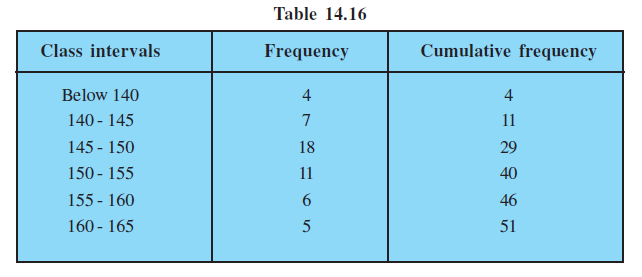
Now n = 51. So,  . This observation lies in the class 145 - 150. Then,
. This observation lies in the class 145 - 150. Then,
l (the lower limit) = 145,
cf (the cumulative frequency of the class preceding 145 - 150) = 11,
f (the frequency of the median class 145 - 150) = 18,
h (the class size) = 5.
Using the formula, Median = l +  , we have
, we have
Median = 
= 145 +  = 149.03.
= 149.03.
So, the median height of the girls is 149.03 cm.
This means that the height of about 50% of the girls is less than this height, and 50% are taller than this height.
Example 8 :
The median of the following data is 525. Find the values of x and y, if the total frequency is 100.
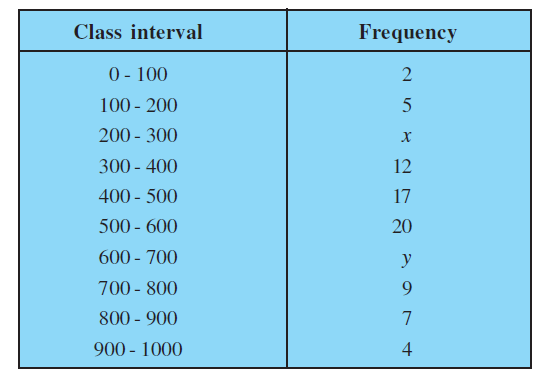
Solution :
Class intervals Frequency Cumulative frequency
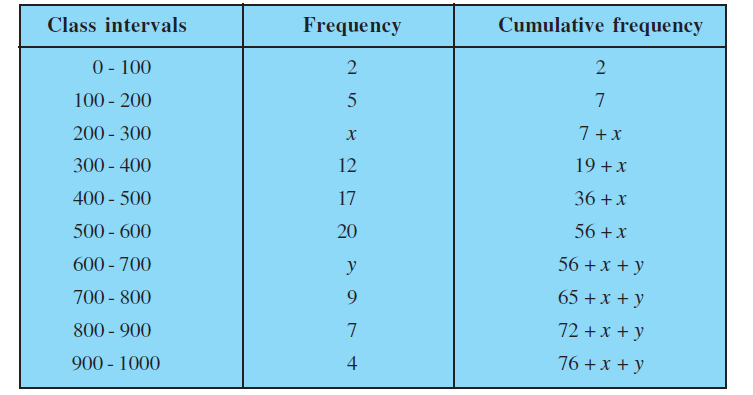
It is given that n = 100
So, 76 + x + y = 100, i.e., x + y = 24 (1)
The median is 525, which lies in the class 500 – 600
So, l = 500, f = 20, cf = 36 + x, h = 100
Using the formula : Median =  we get
we get
525 = 
i.e., 525 – 500 = (14 – x) × 5
i.e., 25 = 70 – 5x
i.e., 5x = 70 – 25 = 45
So, x = 9
Therefore, from (1), we get 9 + y = 24
i.e., y = 15
Now, that you have studied about all the three measures of central tendency, let us discuss which measure would be best suited for a particular requirement.
The mean is the most frequently used measure of central tendency because it takes into account all the observations, and lies between the extremes, i.e., the largest and the smallest observations of the entire data. It also enables us to compare two or more distributions. For example, by comparing the average (mean) results of students of different schools of a particular examination, we can conclude which school has a better performance.
However, extreme values in the data affect the mean. For example, the mean of classes having frequencies more or less the same is a good representative of the data. But, if one class has frequency, say 2, and the five others have frequency 20, 25, 20, 21, 18, then the mean will certainly not reflect the way the data behaves. So, in such cases, the mean is not a good representative of the data.
In problems where individual observations are not important, and we wish to find out a ‘typical’ observation, the median is more appropriate, e.g., finding the typical productivity rate of workers, average wage in a country, etc. These are situations where extreme values may be there. So, rather than the mean, we take the median as a better measure of central tendency.
In situations which require establishing the most frequent value or most popular item, the mode is the best choice, e.g., to find the most popular T.V. programme being watched, the consumer item in greatest demand, the colour of the vehicle used by most of the people, etc.
Remarks :
1. There is a empirical relationship between the three measures of central tendency :
3 Median = Mode + 2 Mean
2. The median of grouped data with unequal class sizes can also be calculated. However, we shall not discuss it here.
Exercise 14.3
1. The following frequency distribution gives the monthly consumption of electricity of 68 consumers of a locality. Find the median, mean and mode of the data and compare them.
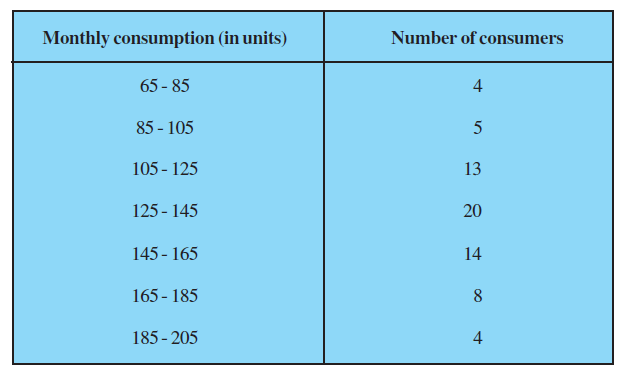
2. If the median of the distribution given below is 28.5, find the values of x and y.
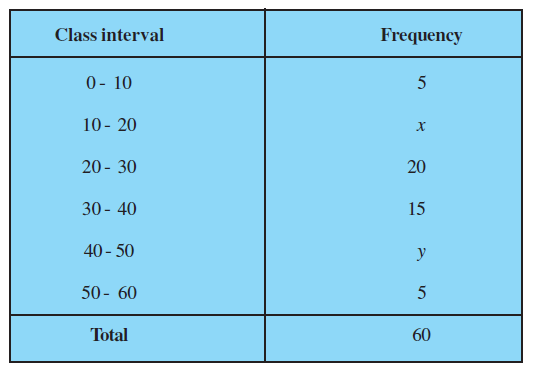
3. A life insurance agent found the following data for distribution of ages of 100 policy holders. Calculate the median age, if policies are given only to persons having age 18 years onwards but less than 60 year.
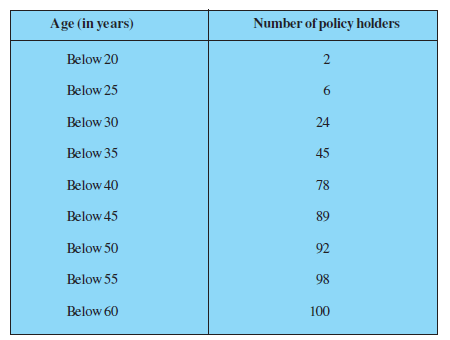
4. The lengths of 40 leaves of a plant are measured correct to the nearest millimetre, and the data obtained is represented in the following table :
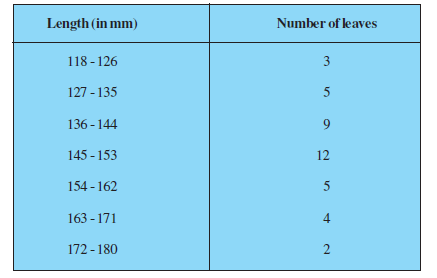
Find the median length of the leaves.
(Hint : The data needs to be converted to continuous classes for finding the median, since the formula assumes continuous classes. The classes then change to
117.5 - 126.5, 126.5 - 135.5, . . ., 171.5 - 180.5.)
5. The following table gives the distribution of the life time of 400 neon lamps :
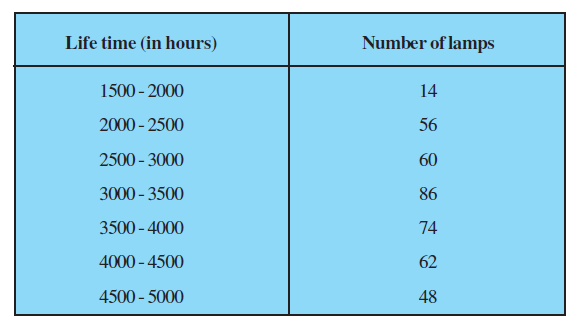
Find the median life time of a lamp.
6. 100 surnames were randomly picked up from a local telephone directory and the frequency distribution of the number of letters in the English alphabets in the surnames was obtained as follows:

Determine the median number of letters in the surnames. Find the mean number of letters in the surnames? Also, find the modal size of the surnames.
7. The distribution below gives the weights of 30 students of a class. Find the median weight of the students.

14.5 Graphical Representation of Cumulative Frequency Distribution
As we all know, pictures speak better than words. A graphical representation helps us in understanding given data at a glance. In Class IX, we have represented the data through bar graphs, histograms and frequency polygons. Let us now represent a cumulative frequency distribution graphically.
For example, let us consider the cumulative frequency distribution given in Table 14.13.
Recall that the values 10, 20, 30, . . ., 100 are the upper limits of the respective class intervals. To represent the data in the table graphically, we mark the upper limits of the class intervals on the horizontal axis (x-axis) and their corresponding cumulative frequencies on the vertical axis (y-axis), choosing a convenient scale. The scale may not be the same on both the axis. Let us now plot the points corresponding to the ordered pairs given by (upper limit, corresponding cumulative frequency), i.e., (10, 5), (20, 8), (30, 12), (40, 15), (50, 18), (60, 22), (70, 29), (80, 38), (90, 45), (100, 53) on a graph paper and join them by a free hand smooth curve. The curve we get is called a cumulative frequency curve, or an ogive (of the less than type). (see Fig. 14.1)

Fig. 14.1
The term ‘ogive’ is pronounced as ‘ojeev’ and is derived from the word ogee. An ogee is a shape consisting of a concave arc flowing into a convex arc, so forming an S-shaped curve with vertical ends. In architecture, the ogee shape is one of the characteristics of the 14th and 15th century Gothic styles.
Next, again we consider the cumulative frequency distribution given in
Table 14.14 and draw its ogive (of the more than type).
Recall that, here 0, 10, 20, . . ., 90 are the lower limits of the respective class intervals 0 - 10, 10 - 20, . . ., 90 - 100. To represent ‘the more than type’ graphically, we plot the lower limits on the x-axis and the corresponding cumulative frequencies on the y-axis. Then we plot the points (lower limit, corresponding cumulative frequency), i.e., (0, 53), (10, 48), (20, 45), (30, 41), (40, 38), (50, 35), (60, 31), (70, 24), (80, 15), (90, 8), on a graph paper, and join them by a free hand smooth curve.
The curve we get is a cumulative frequency curve, or an ogive (of the more than type). (see Fig. 14.2)

Fig. 14.2
Remark :
Note that both the ogives (in Fig. 14.1 and Fig. 14.2) correspond to the same data, which is given in Table 14.12.
Now, are the ogives related to the median in any way? Is it possible to obtain the median from these two cumulative frequency curves corresponding to the data in Table 14.12? Let us see.
One obvious way is to locate  on the y-axis (see Fig. 14.3). From this point, draw a line parallel to the x-axis cutting the curve at a point. From this point, draw a perpendicular to the x-axis. The point of intersection of this perpendicular with the x-axis determines the median of the data (see Fig. 14.3).
on the y-axis (see Fig. 14.3). From this point, draw a line parallel to the x-axis cutting the curve at a point. From this point, draw a perpendicular to the x-axis. The point of intersection of this perpendicular with the x-axis determines the median of the data (see Fig. 14.3).
Another way of obtaining the median is the following :

Fig. 14.3
Fig. 14.4
Draw both ogives (i.e., of the less than type and of the more than type) on the same axis. The two ogives will intersect each other at a point. From this point, if we draw a perpendicular on the x-axis, the point at which it cuts the x-axis gives us the median (see Fig. 14.4).
Example 9 :
The annual profits earned by 30 shops of a shopping complex in a locality give rise to the following distribution :
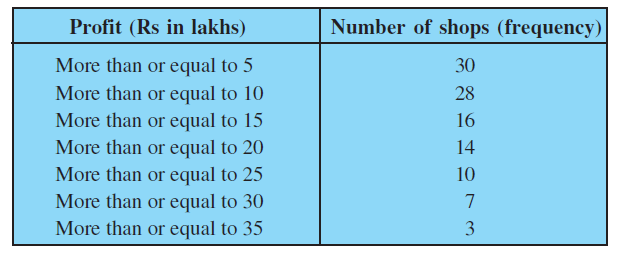
Draw both ogives for the data above. Hence obtain the median profit.
Solution :
We first draw the coordinate axes, with lower limits of the profit along the horizontal axis, and the cumulative frequency along the vertical axes. Then, we plot the points (5, 30), (10, 28), (15, 16), (20, 14), (25, 10), (30, 7) and (35, 3). We join these points with a smooth curve to get the ‘more than’ ogive, as shown in
Fig. 14.5.
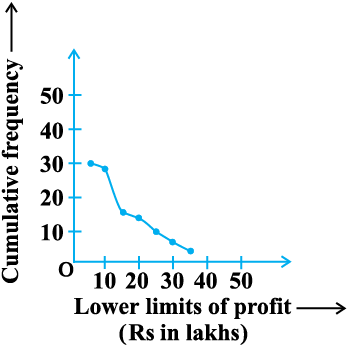
Fig. 14.5
Now, let us obtain the classes, their frequencies and the cumulative frequency from the table above.

Using these values, we plot the points
(10, 2), (15, 14), (20, 16), (25, 20), (30, 23),
(35, 27), (40, 30) on the same axes as in Fig. 14.5 to get the ‘less than’ ogive, as shown in Fig. 14.6.
The abcissa of their point of intersection is nearly 17.5, which is the median. This can also be verified by using the formula. Hence, the median profit (in lakhs) is
ruupee 17.5.

Fig. 14.6
Remark :
In the above examples, it may be noted that the class intervals were continuous. For drawing ogives, it should be ensured that the class intervals are continuous. (Also see constructions of histograms in Class IX)
Exercise 14.4
1. The following distribution gives the daily income of 50 workers of a factory.

Convert the distribution above to a less than type cumulative frequency distribution, and draw its ogive.
2. During the medical check-up of 35 students of a class, their weights were recorded as follows:
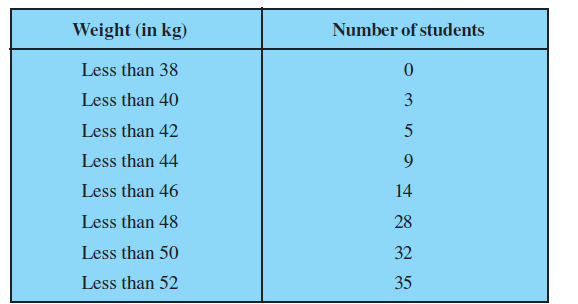
Draw a less than type ogive for the given data. Hence obtain the median weight from the graph and verify the result by using the formula.
3. The following table gives production yield per hectare of wheat of 100 farms of a village.

Change the distribution to a more than type distribution, and draw its ogive.
14.6 Summary
In this chapter, you have studied the following points:
1. The mean for grouped data can be found by :
(i) the direct method : 
(ii) the assumed mean method : 
(iii) the step deviation method :  ,
,
with the assumption that the frequency of a class is centred at its mid-point, called its class mark.
2. The mode for grouped data can be found by using the formula:
Mode = 
where symbols have their usual meanings.
3. The cumulative frequency of a class is the frequency obtained by adding the frequencies of all the classes preceding the given class.
4. The median for grouped data is formed by using the formula:
Median =  ,
,
where symbols have their usual meanings.
5. Representing a cumulative frequency distribution graphically as a cumulative frequency curve, or an ogive of the less than type and of the more than type.
6. The median of grouped data can be obtained graphically as the x-coordinate of the point of intersection of the two ogives for this data.
A Note to the Reader
For calculating mode and median for grouped data, it should be ensured that the class intervals are continuous before applying the formulae. Same condition also apply for construction of an ogive. Further, in case of ogives, the scale may not be the same on both the axes.

